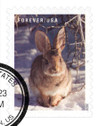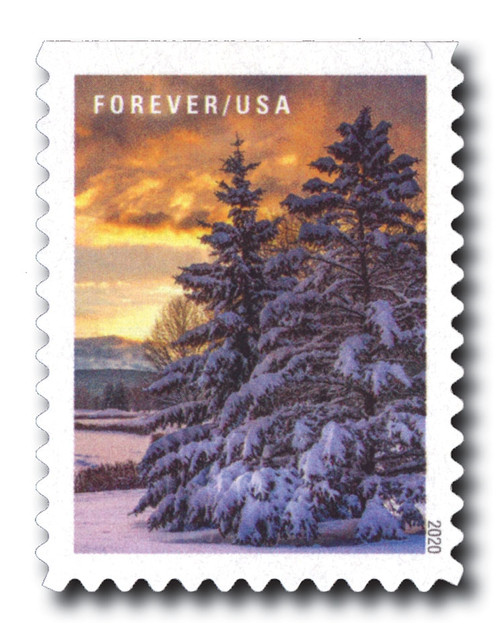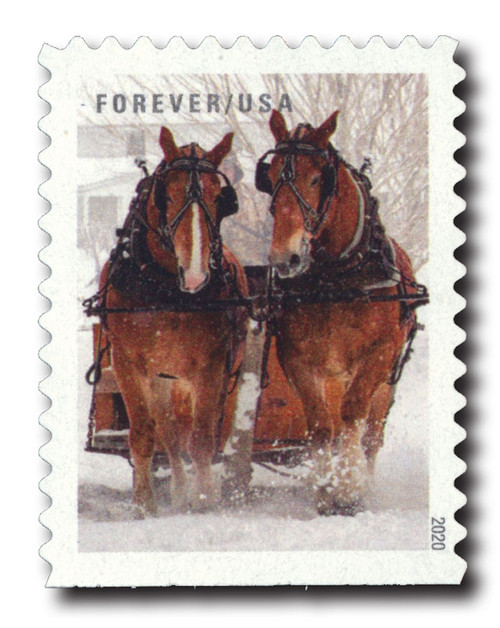
# 5539 - 2020 First-Class Forever Stamps - Winter Scenes: Rabbit
US #5539
2020 Cottontail Rabbit – Winter Scenes
- One of 10 stamps picturing snowy scenes showing off just how beautiful winter can be
Stamp Category: Commemorative
Set: Winter Scenes
Value: 55¢ First Class Mail Rate (Forever)
First Day of Issue: October 16, 2020
First Day City: Winter Park, Florida
Quantity Issued: 400,000,000
Printed by: Ashton Potter (USA) Ltd.
Printing Method: Offset
Format: Double-sided booklets of 20
Tagging: Nonphosphored type III, block tag
Why the stamp was issued: To remember the fun of seeing a little rabbit bounding across a snowy field.
About the stamp design: Pictures a photograph of cottontail rabbit sitting in the sun on a snowy day.
First Day City: The First Day of Issue Ceremony was held virtually due to the Covid-19 pandemic with a First Day of Issue postmark from Winter Park, Florida.
About the Winter Scenes set: A set of 10 stamp designs picturing different photographs of animals, buildings, and landscapes in winter. Meant as reminders that winter isn’t all cold and snow, it has moments of real beauty, too.
History the stamp represents: The northern regions of North America are home to many animal species that hibernate during cold winter months. However, some, like the eastern cottontail rabbit, stay active all year long.
The eastern cottontail rabbit has the highest population of any rabbit species in North America. It lives in meadows or open fields with lots of available food. These rabbits also need shrubby areas to provide cover from predators.
Since eastern cottontail rabbits are herbivores, they eat a wide range of plants during the spring, summer, and fall months. Wen winter arrives, their diet changes a little. They transition to eating bark, twigs, and buds of shrubs and small trees. Most of the eastern cottontail rabbit’s foraging occurs after the sun sets, allowing them to avoid predators that rely on daylight to hunt.
During the winter, it’s fairly easy to tell if an eastern cottontail rabbit has visited your yard. It leaves an obvious pattern of tracks in the snow consisting of two longer ovals for the hind feet and smaller ovals for the front. In general, the tracks of an adult rabbit are up to 4 inches long and around 1.5 inches wide. It is always fun to go out into the yard after a fresh winter snowfall and see if any rabbits came by for a visit.
US #5539
2020 Cottontail Rabbit – Winter Scenes
- One of 10 stamps picturing snowy scenes showing off just how beautiful winter can be
Stamp Category: Commemorative
Set: Winter Scenes
Value: 55¢ First Class Mail Rate (Forever)
First Day of Issue: October 16, 2020
First Day City: Winter Park, Florida
Quantity Issued: 400,000,000
Printed by: Ashton Potter (USA) Ltd.
Printing Method: Offset
Format: Double-sided booklets of 20
Tagging: Nonphosphored type III, block tag
Why the stamp was issued: To remember the fun of seeing a little rabbit bounding across a snowy field.
About the stamp design: Pictures a photograph of cottontail rabbit sitting in the sun on a snowy day.
First Day City: The First Day of Issue Ceremony was held virtually due to the Covid-19 pandemic with a First Day of Issue postmark from Winter Park, Florida.
About the Winter Scenes set: A set of 10 stamp designs picturing different photographs of animals, buildings, and landscapes in winter. Meant as reminders that winter isn’t all cold and snow, it has moments of real beauty, too.
History the stamp represents: The northern regions of North America are home to many animal species that hibernate during cold winter months. However, some, like the eastern cottontail rabbit, stay active all year long.
The eastern cottontail rabbit has the highest population of any rabbit species in North America. It lives in meadows or open fields with lots of available food. These rabbits also need shrubby areas to provide cover from predators.
Since eastern cottontail rabbits are herbivores, they eat a wide range of plants during the spring, summer, and fall months. Wen winter arrives, their diet changes a little. They transition to eating bark, twigs, and buds of shrubs and small trees. Most of the eastern cottontail rabbit’s foraging occurs after the sun sets, allowing them to avoid predators that rely on daylight to hunt.
During the winter, it’s fairly easy to tell if an eastern cottontail rabbit has visited your yard. It leaves an obvious pattern of tracks in the snow consisting of two longer ovals for the hind feet and smaller ovals for the front. In general, the tracks of an adult rabbit are up to 4 inches long and around 1.5 inches wide. It is always fun to go out into the yard after a fresh winter snowfall and see if any rabbits came by for a visit.














